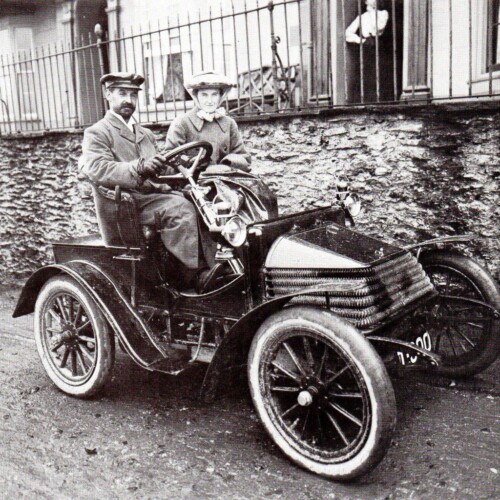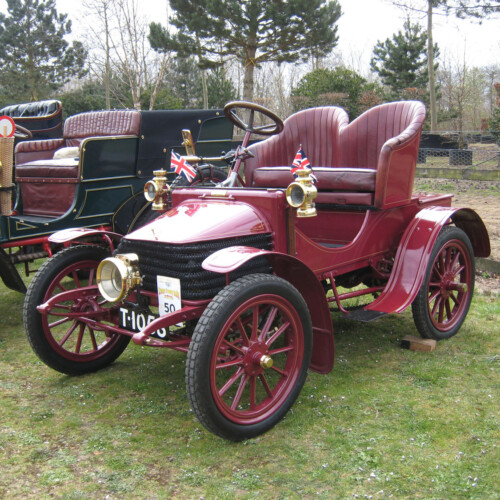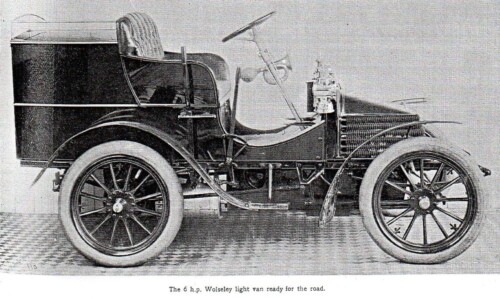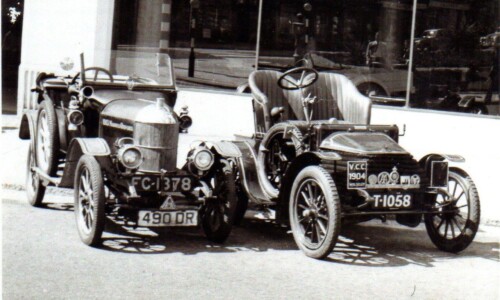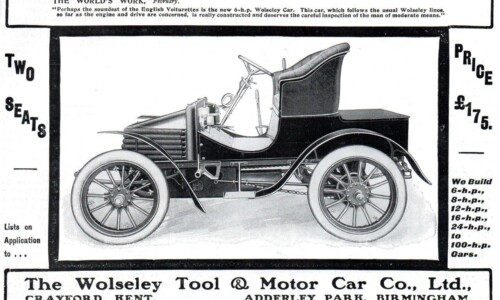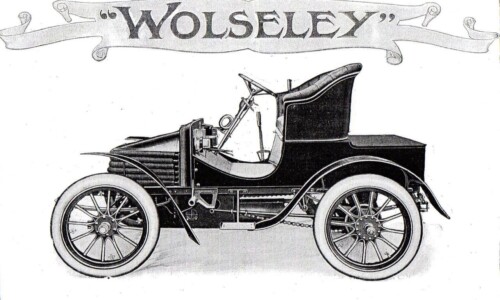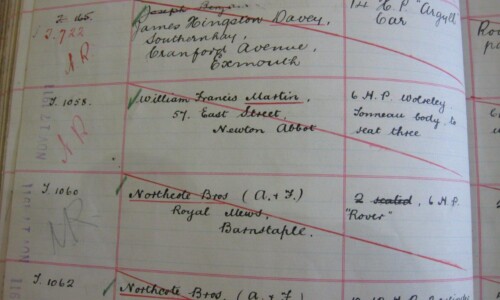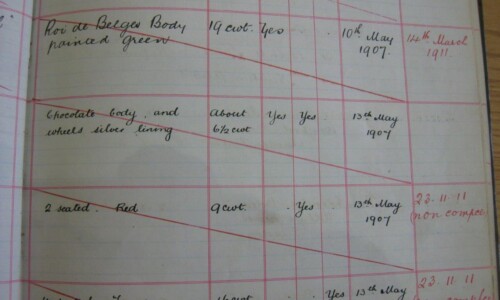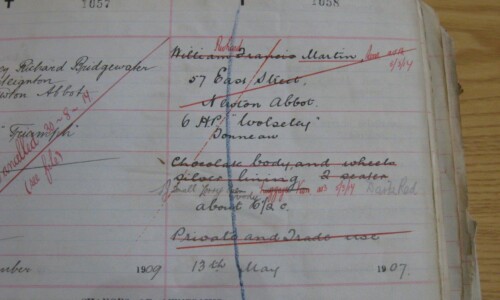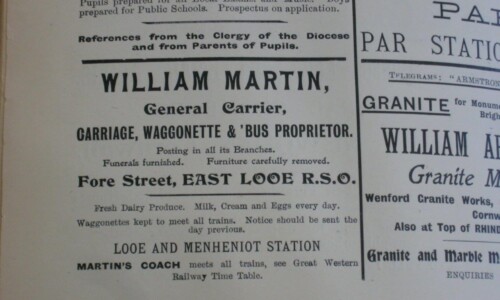My interest in old vehicles came from watching the London to Brighton Runs that came right past the family home in Crawley. From a very young age I watched all the Runs (cars, commercials and motorcycles) and always wanted to take part one day. I bought my first old vehicle, a 1950 Bedford lorry, on my 20th birthday in 1982 and then restored it over the next 5 years before driving it on the London to Brighton Historic Commercial Vehicle Run many times. Over the years I owned and restored many vintage cars, a couple of vans and even a 1953 Guy bus. One very important thing for me has always been tracing as much history as possible about any vehicle I own. Any information found should be carefully recorded and passed on to future owners.
I continued to watch the Veteran Car Run each November and always wanted to own a veteran but the cost of buying was a major obstacle. When I turned 40 years of age I decided the time had come so I sold a couple of vintage cars and started looking for a suitable veteran car. In February 2003 Bonhams were due to auction a 1904 Wolseley 6hp single that caught my eye. I went to the auction venue at Hendon on the viewing day and spent a long time checking over the car. While there I was approached by a gentleman who introduced himself as Brian Moore. He told me that he had owned this Wolseley for a short time in the late 1960’s and that he still had the old buff log book for it. He gave me his contact details and said that he would pass it on to me if I was the winning bidder. Sadly on the day of the auction I bid to my maximum budget but missed out by just one bid and the car sold to Mike Timms.
Before the Bonhams auction I had been to view a 1903 Humberette but turned it down for various reasons, but mainly because I wanted the Wolseley. While viewing the Wolseley I overheard two people talking and they said that if they weren’t successful bidding for the Wolseley they would buy the Humberette. Having missed out on the Wolseley I didn’t want to also miss out on the Humberette so the very next morning I contacted the seller and bought it that afternoon.
Two years later Mike Timms offered the Wolseley to me so I grabbed the chance and quickly sold the Humberette. Over the following winter I completely dismantled the Wolseley and rebuilt it. During this restoration I discover that the chassis and running gear are very original, as is the radiator and bonnet. Several parts including the bonnet catch are stamped with the engine number. The front wings, or at least the mounting brackets, may well be original but the wooden body parts and seat are 1952 replacements. The reason why the body isn’t original became clear years later.
As soon as I got the car home I started looking into the history of it by going through the paperwork that came with it. That didn’t tell me much as there was little more than the VCC Dating Certificate dated October 1952 and a modern registration document. The Bonhams auction catalogue told me that for over 30 years the car had been part of a major British car collection, and the VCC Handbook confirmed this to be the Yorkshire Car Collection. So at this stage I had very little information. My next port of call was my collection of Brighton Run programmes. I have an almost complete set, just missing 1929 and 1934 if there are any offers? These showed that my Wolseley first took part in 1952 when it was entered by Dick Barton. It then took part another 5 times in his ownership before a further 9 Runs entered by the Black family from Yorkshire. In the 1953 programme there is a picture of my car taken on the 1952 Run with 3 people aboard. The third person is sitting on the floor with his legs hanging over the side. A most uncomfortable way to travel to Brighton! The caption tells us that this was Maurice Gatsonides, the well-known Dutch rally driver. Gatsonides, or Gatso as he was often called, was the winner of the 1953 Monte Carlo Rally and in more recent years was the inventor of the Gatso speed camera.
I paid a visit to Ashwell to do some research in the library and also to view the Dating File for my car. The library proved useful for information about the model of Wolseley and I kept the photocopier busy as I trawled through various periodicals. The earliest reports I found were in the Autocar of December 19th 1903 where there was an illustration of the new 6 h.p. Wolseley that had been displayed at the Late Paris Salon. When I came to check the Dating File sadly it was rather thin with little more than the application form. This was disappointing as some files are crammed full of information and photographs. But I did learn that the car was restored by Dick Barton of the Barton Motor Company in Plymouth. The Dating Report states “This car is a standard 6 H.P. Wolseley as made in 1904 and 1905. Its engine number is the lowest of the ten examples of this model existing, and I am satisfied that it was made early in 1904. That it was intended to become a 6 H.P. Siddeley seems clear from the Car No. which is in the V or Siddeley series and not in the 8000 Wolseley series”.
The main Wolseley factory was at Adderley Park in Birmingham where all the twin and four cylinder models were made, but the little single-cylinder cars were made in the Vickers factory at Crayford in Kent. This same factory also made the near identical 6 H.P. Siddeley, the only difference being the radiator and bonnet. The surviving Siddeley cars have Car numbers between V53 and V270, and the surviving Wolseleys have numbers between 8178 and 8398. So was my Wolseley, Car No. V45, originally set down as a Siddeley but then out-shopped as a Wolseley as suggested in the Dating Report? Maybe there was a cancelled order for a Siddeley so the car had the radiator and bonnet changed to suit the next order? Or could it be that initially all cars being produced at the Vickers factory would have a car number stating with V (for Vickers) but this idea was later changed? No factory records survive so we will probably never know. One thing for sure is that mine is the earliest known surviving car from the Crayford factory. The chassis frame on my car has been formed from one piece of steel channel that starts at one front dumb-iron, has 90 degrees bends at the back to form the rear cross member, and then comes down the side to the other front dumb-iron. The total length of this channel is 17 feet 4 inches. This single piece channel is clearly seen in early motoring magazine reports and factory illustrations. Later cars had a separate riveted rear cross member. The only surviving car I have seen with the same chassis layout as mine is the 6 H.P. Siddeley (Car No. V53) in Brooklands museum.
I tried to trace Dick Barton but he hadn’t been a VCC member for many years and I could find no trace of him in the Plymouth area. Recently I picked up a copy of Classic and Sportscar magazine from February 2007 which includes a 4 page feature on Dick Barton written by Jon Pressnell. A missed opportunity for me as clearly Dick was still alive when I first bought the Wolseley. Dick would have been able to tell me so much about where he found the car and what condition it was in.
The registration number, T1058, is a Devon issue and as the original registration records still survive I contacted the Devon Records Office in Exeter. They were able to supply me with a copy of the original entry which shows it was first registered on 13th May 1907 to William Francis Martin, 57 East Street, Newton Abbott. The car was described as a 6 H.P. Wolseley with Tonneau body to seat three. The body and wheels were painted chocolate and lined in silver. Weight unladen was about 6 ½ cwt. It was licensed for both trade and private purposes. From this it was clear that the car must have been previously registered with a different number which may well have been retained by the original owner when he sold the car when it was three years old. Not an unusual thing as registrations have been cherished since they first appeared in 1903.
In my search for all things Wolseley I found an old photograph of a six horse power Wolseley taken c.1906 in Torquay. The registration number is T 300, just the sort of number that an owner would want to retain and transfer to his next car. Could this be my car? I had to make a visit to the Devon Records Office to search through the ledgers to try and identify the original registration for my car. Lack of spare time and the near 400 mile round trip meant that it would be another 12 years before I got there.
My next avenue was to contact Brian Moore who had spoken with me at the Bonhams auction. Fortunately I had written his details in the back of my catalogue. Brian was a real gold mine of information as he was able to supply me with two log books, a photograph, a Ministry of Transport Test Certificate (MOT) for 1966, and other interesting information. One of the log books was an old buff coloured one with details back to 1924 and the other one was a later green coloured log book. The log book shows that in 1924 it was owned by W. Treffry Hosking of Shillingham Manor, near Saltash in Cornwall. An internet search showed that the Hosking family had lived here for generations. On 4th May 1950 the Western Morning News reported that “wedding yesterday of Mr John Treffry Hosking, only son of Mrs E Hosking and the late Mr W Treffry Hosking of Shillingham Manor, Saltash”. I added Shillingham Manor to my list of places to visit but alas another missed opportunity as the estate was sold by the Hosking family in 2010. Brian Moore was able to tell me that in 1968 Dick Barton advertised the Wolseley for sale together with a 1913 Bullnose Morris with an asking price of £3000 the pair. Brian only wanted the Morris so he asked Dick if he was prepared to sell him just the Morris. No problem was the reply but the price would still be £3000 if he only took the one car. So naturally Brian had to take both! With no interest in the Wolseley it was quickly sold on, in August 1968, to Thomas Black in Yorkshire.
My remaining area of research was the Devon Records Office in Exeter which I finally visited in March 2017. Here they hold the original hand-written vehicle registers that are freely available for inspection. I started with the first three volumes that cover motor cars and motor cycles from 1903 to 1910, registrations T1 to T1800. In Devon they split cars and motor cycles by issuing even numbers to motor cars and odd numbers to motor cycles. I felt very privileged to be handling these documents and I was fascinated by the information they contain. Reading through the entries it was clear which manufacturers had agents in the area by the large number of cars of those makes. Wolseley had Messrs Reeve & Co of 21 Bank Street, Newton Abbott as their agent and there were a total of 55 Wolseleys registered. 20 of their 6hp cars, 17 x 8hp, 9 x 10hp, 5 x 12hp and one each of 5hp, 16hp, 20hp and 25hp. There were 70 De Dion Boutons of various horse-power. There were lots of MMC, Siddeley, Singer, Vauxhall, Jackson Dogcarts, and several other makes. There were several makes I had never heard of and I was also surprised by how many cars were listed as unknown manufacture or home-made. I was also surprised at how few Ford cars had been registered in Devon. The registers include the name and address of the owner, the car details, body colour and any lining colours, the weight and the intended use of the car. I went through every registration entry looking for all Wolseleys and made a note of every one. I was hoping to find an entry for my car under an earlier registration number to explain why it was re-registered in 1907. I found the entry for T300 that I mentioned earlier but I was able to establish that it wasn’t my car. T300 was listed as a 6 ½ h.p. Little Wolseley car with 2-seated body coloured green and picked out in fine primrose lines. Sadly not my car as the colour scheme was wrong and it was still licensed in 1917. Today T300 is on a 2014 BMW. I was hoping to find a chocolate painted car which had then been re-registered but no suitable candidate was found.
The original entry for each car was written in black ink, but when there was a change of details the original entry had a diagonal red line drawn across the whole entry and then a new entry for that registration was added in red ink in the next available space further in the register. So initially entries were in order (T2, T4, T6, T8, etc.) but then when there was a change in details the registrations became out of order so you have T534 in black, followed by T432 in red, then T536 in black, T130 in red and T538 in black. Some registrations appeared several times across the three volumes I looked at. It certainly got the little grey matter working to sort all those out!
Having gone carefully through all three volumes up to T1800, I turned to another register book. The Register of Motor Car Licences (T1 to T1800) Re-Registrations. In this register there were numerous changes to many cars and now all alternations in the records were done by crossing out what had changed and writing the new details above. Where they ran out of space on any particular registration number a piece of paper was attached over the top. This is where I hit the jackpot for information on my car. On 17th March 1917 ownership passed from William Martin of 57 East Street, Newton Abbott to Richard Martin of the same address. At the same time the body type was changed to Luggage Van. Later, luggage van was crossed out and replaced by Small Lorry Open Body. It must have been a very small lorry! At the same time the colour was changed to dark red. On 1st September 1920 ownership changed to Edward H. Blake of Wilnecote Gardens, Furze Hill Road, Torquay. This person was either a motor dealer or quickly changed his mind as three weeks later there was another change of ownership as on the 27th September 1920 the Wolseley passed to Albert William Jaggers of 54 Windsor Road in Torquay. At this stage it was still licensed for trade purposes. Looking into another register I found yet another owner as it’s recorded that on 8th October 1921 ownership passed to Arthur March R.N. (Royal Navy). His address is given as HMS Defiance, Devonport. At the same time intended use was changed from trade to private car. Amazing that a totally out-dated 17 year old car was still in use. The final known change of ownership comes from the buff log book which records that on 2nd September 1924 it was registered to W. Treffry Hosking of Shillingham Manor, as mentioned earlier.
There were still other registers that may hold information but I was fast running out of time before the Records Office closed for the day and before that I wanted to check out the Kelly’s Business Directories for Devon. The 1902 Directory lists William Martin (the owner from 1907) as a General Carrier, and Carriage, Waggonette and Bus Proprietor. The same directory lists Richard Martin (owner from 1917) as Coach and Van Builder trading under the name of South Devon Carriage and Waggon Works, East Street, Newton Abbott. The 1906 Kelly’s Directory has an advert for William Martin that includes more of the services he carried out and shows that he had a number of branches for the business.
By now I had been in the Records Office for over 6 hours and was pushed out of the door at 5pm. I must go back as there are more sources of information to investigate. I mustn’t leave it another 12 years, but 3 years have already zoomed by since my last visit.
I failed in my original quest to find out of the first registration number for my Wolseley but have learned far more than I ever imagined and have thoroughly enjoyed the search so far. With no trace in the Devon records it seems likely that my car was originally registered elsewhere and didn’t arrive in Devon until 1907. It was fascinating to learn that it had at one time been a luggage van and later an open-back lorry. That would help to explain why a replacement car body was constructed in 1952 but it would still be good to know what condition it was found in at that time.
Wolseley did offer van bodywork and in The Motor Traction magazine of June 22nd, 1905 there is a four page report on the Wolseley 6 h.p. Light Van. Maybe I should put my car back to a van? Now that would certainly be an interesting project.
David Ralph

